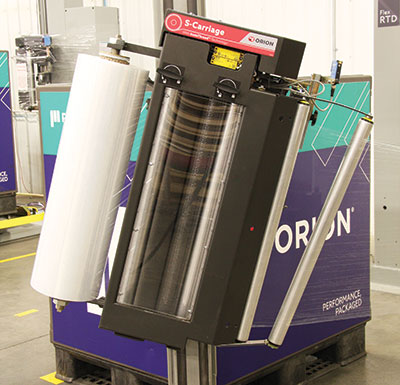The story behind automated stretch wrapping of unitized loads is relatively simple, explains Pat Pownall, director of sales at Orion.
“All you’re trying to do is get a load from point A to point B safely and securely,” Pownall says. “Stretch wrapping keeps the load stable and protected from most types of damage when in transit.”
And then Pownall pauses.
“The challenge is to make that happen at the lowest cost and with the least amount of stretch wrap film load after load after load,” he continues.
This is where stretch wrapping gets interesting. But fortunately, several recent developments have actually become the story behind the upward trajectory of unitization lately.
Pownall starts here with what he has absolutely no control over: stretch wrap film. “The film industry has done an absolutely remarkable job in R&D,” he says. Many films today can be stretched from 300% to 500%. At the same time, most stretch wrappers typically stretch the film in the 250% to 300% range.
In other words, some of these petroleum-based films are actually overqualified for certain applications. That allows operations a chance to re-evaluate the value they’re getting from films currently in use, especially in a time of rising oil costs. Pownall also notes that the story here is really about matching as closely as possible the film’s stretch properties to those needed for the application.
Then there’s the matter of wrapping loads consistently. This is where the art of stretch wrapping comes into the picture. Or is actually being removed from the picture as it turns out.
Even with automated stretch wrappers, operators have historically had the final say in the wrap recipe—stretch percentage and wrap pattern. But that’s changing. Machines with buttons and knobs controlled by operators continue to be replaced by those with touchscreen human-machine interface (HMI) controls. Orion, for instance, has offered only HMI machines for several years.
Typically, HMI controls lock out the operator from a personal fine tuning of the wrap recipe. “HMI controls prevent operators from overthinking the recipe while ensuring absolute consistency load to load,” says Pownall. HMI controls also compensate for many of those highly experienced operators retiring with the recipe in their heads, he adds.
But as it turns out, there’s more to success today than a consistent wrap recipe, says Pownall. Last year, Orion introduced a stretchwrapper with what is called an S-Carriage. It’s different in a couple of ways.
First, Pownall points out that the S-Carriage really improves upon what many consider to be the most important component of a stretch wrapper—the carriage. At heart of the design are two pre-stretched rollers. Film travels in an S pattern around the rollers, providing more than 180 degrees of film contact to reduce slippage and neckdown.
The result is a consistent pre-stretch of 260% at different tensions and 1 inch less neckdown. He adds that achieving this consistent level of pre-stretch means end users can wrap faster while receiving better film yield.
Also, it reduces film acquisition costs and improves end-user sustainability by reducing waste. In fact, the S-design typically wraps 154 loads per film roll compared to 135 previously.
By the way, Pownall says the new carriage didn’t happen overnight. Anything but. It took six years of back and forth with end users to get it right, he adds. And from all indications, that effort has paid off for lots of stretch wrapped loads.
Article topics










